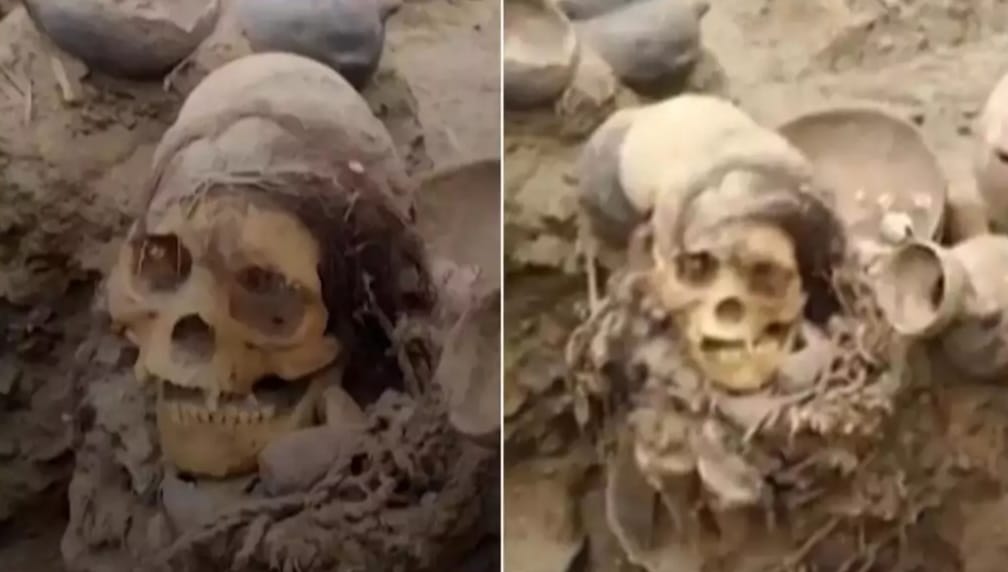1000 year old mummy found in Peru, South America.
Introduction: History Unfolds in South America
In a stunning discovery, utility workers in Lima, Peru have accidentally uncovered a 1000 year old mummy with intact dark brown hair while expanding a natural gas pipeline. This mummy, found in a seated position, offers rare insight into the pre-Hispanic civilizations that once flourished in South America.
Unlike scenes from The Mummy movie franchise like The Mummy Returns or The Mummy 2 film, this real-life mummy doesn’t bring curses—just answers.
The Discovery – How a Natural Gas Project Led to a Historical Breakthrough
While digging near the Peruvian capital, workers stumbled upon something much older than the pipeline they were laying—an ancient burial site believed to date back to 800–1200 AD. The mummy was remarkably well–preserved, still holding onto its dark brown hair, despite lying underground for centuries.
Archaeologist Rafael Pimentel explained that the mummy’s position and surrounding artifacts suggest it was a pre-Hispanic ceremonial burial. This could indicate that the person buried held a significant role in their society—possibly a noble, spiritual figure, or community elder.
Peru’s Mummies vs. Egyptian Mummies: How They Compare
Whenever we hear the word “mummy,” our minds often jump straight to Egypt and mummies wrapped in linen inside pyramids. But Peru, along with other Andean regions, has its own rich legacy of mummification—sometimes even older than Egyptian practices.
Here’s how Peruvian mummies differ from their Egyptian counterparts:
Feature Peruvian Mummies Egyptian Mummies.
Method Natural and ritual drying Embalming and wrapping.
Position Seated, often fetal position Lying flat.
Purpose Spiritual and community rituals Religious preparation for the afterlife.
Burial Items Ceramics, food, textiles Jewelry, amulets, gold.
This recent discovery adds to Peru’s growing collection of ancient remains, giving us a broader view of South American ancient civilizations that rivaled even the Egyptian dynasties in cultural depth.
Who Was This Mummy? Theories and Clues
Although we may never know the individual’s exact identity, archaeologists have clues:
Hair: The dark brown hair was well-preserved, a rare feature after 1000 year.
Seated Posture: Indicates spiritual or ceremonial significance.
Nearby Artifacts: Pottery, textiles, and bones suggest this was a formal burial site.
Experts believe the remains likely belonged to someone from the Chorrillos or Ichma cultures, both known for complex social structures and advanced burial rituals long before the Inca Empire rose to power.
Scientific Importance – What We Can Learn from the Mummy
This mummy isn’t just an ancient corpse—it’s a biological time capsule. Scientists are now preparing for DNA and carbon-dating tests to uncover:
- The mummy’s diet and lifestyle.
- Any diseases or genetic disorders.
- Cultural rituals based on burial patterns.
- Whether the person was native to Lima or migrated from another region.
This information helps us paint a clearer picture of pre-Hispanic life in Peru, including how communities survived, thrived, and connected across the Andes.
Best Scenes Of The Mummy Returns.
Pop Culture and Real History – The Mummy Returns in Reality
Thanks to hit films like The Mummy 1999, The Mummy 3 film, and 2017 Mummy, there’s been a surge in global fascination with ancient remains. But while those movies showcase fantasy, real-world discoveries like this prove that truth is sometimes stranger—and even more fascinating—than fiction.
These findings often spark new debates, attract tourists, and fuel museum exhibitions around the world. And unlike the Egypt mummy tropes we’re used to, Peru’s mummies are now making their own headlines.
FAQs
Q1: What is the oldest mummy found in Peru?
The Spirit Cave mummy in nearby Chile is over 5,000 years old, but Peru has preserved mummies over 1,500 years old, especially from the Nazca and Chinchorro cultures.
Q2: Can mummies still have hair?
Yes, especially in dry and stable climates like Peru’s desert regions, hair and skin can remain intact for centuries due to natural preservation.
Q3: Why are mummies found in a seated position in Peru?
The fetal or seated posture is symbolic in many Andean cultures, often representing rebirth, spiritual readiness, or a return to Mother Earth (Pachamama).
Q4: Are there any new mummy discoveries in Egypt?
Yes, Egypt continues to uncover mummies in the Valley of the Kings and Saqqara, but South America is gaining attention for equally important finds like this one.
The Global Buzz – Media and Archaeology Communities React
The discovery has gone viral, trending on social media and attracting coverage from global outlets like BBC, Republic World, and Al Jazeera. Experts across the archaeological community are calling it “one of the most significant finds in recent years.”
Many are urging for preservation efforts and further excavations in the area before more infrastructure projects disturb unexcavated sites.
Why These Discoveries Matter Today
Ancient finds like this 1000 year old mummy aren’t just about the past—they connect us to the roots of human civilization. They help us:
- Understand ancient cultures and belief systems.
- Recognize the environmental conditions that aid preservation.
- Appreciate the diverse history of South America, beyond European narratives.
- And in times where history often feels distant, discoveries like this bridge the gap between ancient and modern worlds.
Conclusion: A Window into Peru’s Ancient Soul
The 1000 year old mummy with intact dark hair unearthed in Peru is more than a skeleton—it’s a symbol of life once lived, of culture long buried, and of stories now resurfacing. As scientists, historians, and everyday people look closer, we’re reminded that history is never truly lost—it’s just waiting to be rediscovered.
Whether you’re a fan of The Mummy 2 film or just curious about ancient civilizations, this real-world discovery reminds us that South America has its own incredible stories to tell—sometimes just beneath our feet.
Watch Out Panchayat Season 4 For Free.

